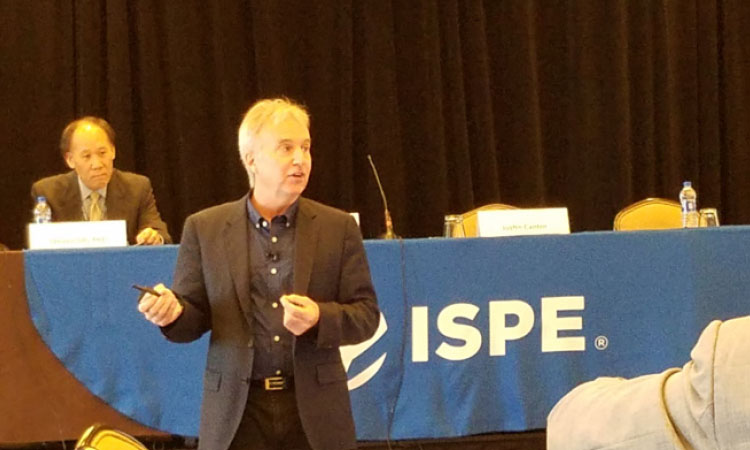Biopharma Growth & Regulatory Perspectives

The 2018 ISPE Biopharmaceutical Manufacturing Conference on 10–12 December in Huntington Beach, California, provided information about future-oriented developments in the burgeoning area of biopharmaceutical manufacturing—and also shared insights into the achievements that are already underway. Regulatory perspectives on how new developments are being assessed were provided by several FDA speakers.
The future was the focus of ISPE’s third biopharma conference, with a look at developing technologies and presentations from FDA speakers with information about how to move forward in obtaining approvals for innovative technologies. Some trends in the biopharma industry were noted by Andre Walker, Principal, Andre Walker Consulting, and chair of the conference program committee, at the conference’s opening plenary.
“We used to talk about monoclonal antibodies, and now we will talk about new modalities,” he said, noting that biopharma is moving toward “turbo-charged” manufacturing, like what is possible with continuous manufacturing. “Our job is to make it compliant and an economic reality for the patients,” Walker said. “We’ve gone from small molecule to large, now we’re going even larger to complete cells.” But new modalities are also “going smaller” as pharma companies that previously strove to keep viruses out of their facilities are retooling to manufacture them. He also anticipates a coming together of the typical small molecule/large molecule divide. For instance, experience with organic solvents is rare in biopharma plants, but “you need them to make nucleic acid therapeutics, and potent compound experience is essential when producing antibody drug conjugates.”
Continuous downstream biopharma is in its early stages, Walker noted—some work has already been accomplished, although not in commercial usage yet, and companies large and small are investing in its development. He encouraged attendees to take the lessons learned from small molecule developers into the biologics continuous manufacturing (CM) space. “It’s up to us to use the regulatory path (small molecule developers) cleared for us to make it a reality. New people, new skills, and new processes are needed.”
FDA and Emerging Technologies
In the opening plenary session on 10 December, Steven S. Oh, Deputy Director, Division of Cellular and Gene Therapies, Office of Tissues & Advanced Therapies, CBER/FDA, provided details about some of the FDA’s activities in support of innovative and emerging technologies. Early interaction with the FDA on biopharma product development is encouraged through INTERACT (Initial Targeted Engagement for Regulatory Advice on CBER producTs, formerly pre-pre-IND interaction), which can garner early FDA feedback.
Oh described recently approved cell therapy and gene therapy products, including the following.
- Provenge (sipuleucel-T): Autologous T-cell immunotherapy for treatment of asymptomatic or minimally symptomatic metastatic castrate-resistant (hormone refractory) prostate cancer.
- Luxturna (voretigene neparvovec): Adeno-associated virus vector-based gene therapy for treatment of patients with confirmed biallelic RPE65 mutation-associated retinal dystrophy.
- Yescarta (axicabtagene ciloleucel): CD19-directed genetically modified autologous T-cell immunotherapy for treatment of adult patients with relapsed or refractory large B-cell lymphoma (DLBCL), primary mediastinal large B-cell lymphoma, high-grade B-cell lymphoma, and DLBCL arising from follicular lymphoma.
- Kymriah (tisagenlecleucel): CD19-directed genetically modified autologous T-cell immunotherapy for treatment of patients up to 25 years of age with B-cell precursor acute lymphoblastic leukemia (ALL) that is refractory or in second or later relapse.
He outlined guidance and resources of interest to biopharma product developers, including Expedited Programs for Serious Conditions—Drugs and Biologics (2014); 21st Century Cures Act Regenerative Medicine Therapies (2016); Expedited Program for Regenerative Medicine Therapies for Serious Conditions: Draft Guidance for Industry; and a website with information about the regenerative medicine advanced therapy (RMAT) designation and early FDA interactions.
RMAT status designation may be sought from the FDA for drugs that are regenerative medicine therapy, which includes cell therapies, therapeutic tissue engineering products, human cell and tissue products, and combination products. Oh said that 22 RMAT designation requests have been granted as of 13 June 2018; six are pending, and 33 have been denied. The denials tend to be for administration reasons such as an inactive IND or no preliminary clinical evidence submitted or insufficient preliminary clinical evidence.


Regulatory Panel Discussion With Q&A
The closing session of the 2018 ISPE Biopharmaceutical Manufacturing Conference on 12 December 2018 was an Industry and Regulatory Panel Discussion led by Joseph Famulare, Vice President, Global Compliance and External Collaboration, Pharma Technical Quality, at Genentech/Roche.
Panel participants were Patricia Hughes, PhD, Branch Chief, Division of Microbiology Assessment, FDA/ CDER; Ingrid Markovic, PhD, Senior Director, US Pharma Technical Regulatory, Genentech; Steven S. Oh, PhD, Deputy Director, Division of Cellular and Gene Therapies, Office of Tissues & Advanced Therapies (OTAT), CBER/FDA; and Juan Torres, PhD, Senior Vice President, Global Quality, Biogen.
Torres addressed how to move from a process model being informational to being part of the control strategy. Once a functioning model is developed the specifics of how it will be utilized in the control strategy and how it will be maintained over time must be conveyed to the regulators for their approval. There is a continuum of thinking on this, depending upon the model’s criticality within the overall control strategy.
Torres continued by considering whether there is a need for a backup to the model. Batch approval is from multiple inputs, and details of this scenario need to be considered in the control strategy. “This will be an even a bigger question if you automate a model to take action based on a process deviation,” he noted. Hughes said, “Yes, that would be a problem.” Oh noted that he is a proponent of advanced control methods, especially for cell and gene therapy. “Bring multiple tools to bear to achieve process control” was his view.
Hughes said that sponsors should not be afraid of new methods such as Raman spectroscopy or rapid (instantaneous) micro even though these might be more sensitive and will give more information than you have had historically. Integrating these new tools into systems provides opportunity for expansion of knowledge and continuous improvement.
Torres agreed, noting that industry must take risks. The only way to learn if anything works is to try to make it a reality. You have to invest in technologies such as virus gene sequencing for viral contamination detection. Markovic agreed and thanked the FDA for actively promoting these new technologies. “The ultimate goal is speed, flexibility, cost.”
“There are some efforts in the cell and tissue engineering space to advance new technologies, which could include continuous manufacturing, plus QC methods,” Oh said. NIIMBL (National Institute for Innovation in Manufacturing Biopharmaceuticals) and BioFab are two organizations that coordinate efforts to develop new technologies.
Famulare asked Oh about structures in CBER for promoting new technologies. Oh said that many cell and gene products start out with advanced technology. CDER has an emerging tech team, but CBER does not. It does have a group who are coming up with even newer advanced testing methods. At the time of the conference, the group had been in existence for six months. Oh suggested using the INTERACT program or having a direct conversation with the relevant office based on technology.
Hughes said that at CDER, a lot of reviewers are not up to speed on the new technologies. They have a center of excellence for this and are trying to understand these new technologies, and they want information from industry to help them understand.
Torres asked whether there are methods for cross-agency alignment on new technologies. Hughes said through FDA’s Program Alignment there is connection between CDER and the inspectors.
In response to an audience question about where FDA recommends companies should go to get a read on regulators’ stance on best practices for new technologies, Hughes said that meetings, conferences, and publications are good sources. “Worst case is to see it first in an IND application,” she said. “Connect with agencies early for direct information.” Markovic suggested ICH as being helpful, noting Q12 is under review and Q13 jut initiated for continuous manufacturing. Hughes added that including information explaining new technology in the application can be very helpful.
Torres noted that there is room to expand intercorporate collaborations such as BioPhorum Operations Group (BPOG). Hughes lauded BPOG and noted some FDA representatives “have been invited.” Oh added that although FDA is excited about interacting, it is mostly for education and FDA does not endorse any technology.
In response to an audience query about rapid microbial detection technology in cell and gene therapy, Hughes said the criticality of sterility is key, and likely of huge value for autologous therapy due to production to patient dosing timelines. Oh said standards are being developed to help with implementation and the National Institute of Standards and Technology is doing so as well.
Famulare asked if rapid micro could be used on existing processes. Hughes was enthusiastic about this and said, “bring them on!” FDA has already approved many, she said.
Famulare asked if parametric releas, which has been accepted for terminally sterilized product, was possible with regards to aseptic processes given some of the newer technologies coming providing stringent controls. Hughes responded that “Ten years ago no, never, but today, why not, but it’s our (industry’s) job to provide proof.” She said many companies are using CMOs, and there are concerns about shortcuts being taken using the same technology for a variety of different products.
Several issues were discussed related to post-approval. Oh said that CBER has prelicense inspection as part of BLA review, and product specialists would accompany inspectors for a PAI. Post license, the inspection goes to ORA, team biologics, and usually a product specialist comes as well. Markovic said she appreciates the close relationship between inspector and product reviewer.
Famulare noted that Q12 says robust quality system and robust inspection history would enable a more streamlined change for a manufacturer. Torres asked what constitutes a robust quality system and said agreement is needed on that, perhaps metrics? Famulare said ISPE has an active initiative, Advancing Pharma Quality. Torres said that his peers had a willingness to share more metrics if it would enable quick innovation approval. Markovic added, “You need a robust quality system, but also robust product knowledge, and a platform of prior knowledge.” She advocates a combined holistic approach that the three must be taken together to ensure quality.
Regulatory Review
During the plenary session on 11 December 2018, Oh presented on “GMP Considerations for Cell and Gene Therapy and Viral Vectors.” Oh outlined some unique CMC challenges presented by cell
and gene therapy products. With autologous therapies (one lot treats one patient), specific concerns include product tracking and segregation, high product variability, limited material or time for testing, short shelf life, manufacturing logistics, and scale-out.
On allogeneic cell bank-based products, specific concerns include donor eligibility, qualification of cell banks, reproducibility of replacement bank, stability of cell banks and intermediates, and scale-up. Common concerns to both products include mechanism of action, material qualification, challenges establishing specifications, appropriate manufacturing facility, product shipping/handling, and major manufacturing changes.
Phase 1
Phase 1 for cell and gene therapy projects emphasizes safety considerations, Oh said. Expectations are preclinical animal studies conducted using the product manufactured as it will be used for clinical studies; safety of source material, reagents, and processing; safety testing (sterility, endotoxin, mycoplasma, identity, purity, viability, etc.). Some in vitro proof of concept data should exist, as well as demonstrated ability to manufacture the product. Specification should be established to ensure minimum quality, and product sponsors should have preliminary shipping and stability data.
Donor testing and screening for infectious diseases are required for human cells, tissues, or cellular or tissue-based “351” products when source material is collected from allogeneic human donors. CBER guidance documents provide additional detail on what infectious disease must be tested, when donors must be tested, how they are tested, the types of test kits, and where testing must take place. In addition to donor blood testing, donor screening via medical questionnaire must be performed. Donor eligibility screening and testing requirements often differ by country. For example, non-US countries may not use FDA-licensed test kits or CLIA-certified labs, or they may not perform all the nucleic acid and antibody-based testing required. Consult with the FDA early in product development if using source material from non-US donors.
Ancillary materials to be aware of include:
- Research-grade reagents. Where packaging states “not for clinical use, for research purposes only,” Oh said the reagent can be used in CGT manufacturing only if properly quali¬fied and to use the highest grade available.
- Human-derived materials. Human serum albumin requires the use of licensed products, and for autologous or pooled human serum, there are donor eligibility issues.
- Animal-derived materials. Adventitious agents, BSE/TSE issues for bovine materials require attention to the country of origin and age of the herd.
- “Serum-free” media do not always solve the problem.
GMP considerations outlined by Oh include the following:
- For Phase 1, there is more flexibility in how CGMPs compliance is achieved. The suitability of a facility depends on the nature of the product—not all state-of-the-art facilities are ideal for every product.
- GMP may “improve” the product, but mostly it allows the product sponsor to control product quality and safety, and to help ensure manufacturing consistency.
- GMP cannot prevent manufacturing errors from happening but can help ensure that controls are in place to catch them and take appropriate corrective actions.
Phase 2
In Phase 2, Oh said that sponsors often focus on clinical and statistical design, but manufacturing is also important. Phase 2 manufacturing is often “on autopilot” but it may be a good time to implement a major manufacturing change prior to Phase 3 studies. CMC expectations are higher for Phase 3 studies (identity, stability, manufacturing consistency/product comparability). Consider further product characterization and revision of release specifications during Phase 2, and consider manufacturing changes that might be needed to accommodate larger trials. Understand critical quality attributed (CQA), critical process parameters (CPP), and key process parameters (KPP).
For product development, work backward
- Step 1: MOA—How is the product supposed to work in the patient?
- Step 2: TPP—What would you have to study clinically to assess safety and efficacy based on MOA, and what properties does the product need (product labeling)?
- Step 3: CQA—What critical properties do you need to control to achieve the desired safety and potential efficacy?
- Step 4: CPP—What processes need to be controlled to achieve CQA?
- Step 5: KPP—What controls do you need to achieve a consistent process?
Next, Oh outlined establishing specifications. Specifications are defined in ICH Q6B and Q11 as “critical quality standards (CQAs) that are proposed and justified by the product sponsor and approved by regulatory authorities. ... Specifications are chosen to confirm the quality of the DS and DP rather than to establish full characterization and should focus on those characteristics found to be useful in ensuring the safety and efficacy of the DS and DP.” The full product characterization includes testing not performed on every lot. CQA includes product properties where specifications have not yet been established (e.g., potency) or the product sponsor is not sure if it is truly critical (e.g., additional cellular marker).
Phase 3
Oh likened Phase 3 to commercial manufacturing being on training wheels. At Phase 3, the product sponsor should be using as close to the commercial process as is feasible for registration studies. Potency assays should be in place, CQAs should be identified and appropriate specifications should be in place. CPPs should be well-defined—Phase 3 is critical for demonstrating manufacturing consistency. Additional stability data should be collected, but some details are still being worked out to prepare for commercial production.
He noted CQA and CPP are not meant to be static—these should be continually evaluated and revised as needed. This is important, Oh stated, but revise cautiously since tremendous impact is possible on the product. Additional product characterization data may indicate a better way of ensuring quality. Clinical outcome data may provide clues as to what product properties are most important, and additional manufacturing experience may guide CPP and CQA.
Expedited pathways
Expedited pathways present challenges: fast-advancing clinical programs with a timeline that is truncated can mean planning for CMC for commercial scale, for example, or comparability studies needed for scale-up may not be ready yet. Start to think early about planning/conducting CMC changes, “even during Phase 1 if that is what it comes down to.”
Challenges affecting CGTPs (current good tissue practices) on expedited pathways include limited manufacturing experience (comparability studies are not statistically powered, and not enough retention or test samples are available); limited in-process testing (process variables and CPPs are not known); limited assay development (potency, purity) (assays are not qualified, and reference standards not established or adequately characterized); limited product characterization (CQAs not known); limited knowledge of product- and process-related impurities; and limited product stability data collected.
Oh outlined a product life cycle approach to potency measurement. Stepwise assay development includes investigation of biological activity and development of a relevant potency assay. He noted that expedited development does not change the regulatory requirements for a validated measure of biological activity before clinical studies to support safety and efficacy for licensure. Considerations for potency assays at the final cell product level include biological potency assay/mode of action (e.g., cell killing); cytokine production; transduction efficiency; vector copy number. At the vector substance level, biological potency assay/mode of action; infectious titer (critical for MOI determination at the transduction steps) in target cell and/or surrogate cell line.
Process changes
Process changes during the product life cycle are to be expected, and not all of the changes that come will be planned. The product sponsor is responsible to plan for change, report and implement change, and demonstrate product comparability using risk- and science-based approaches. “This is risk-based, so risk assessment is key,” Oh said.
Some examples of process changes include changes in manufacturing steps, starting materials, reagents, vendors, cell culturing conditions, purification scheme, master cell bank, scale-up or scale-out, automation of the process, and manufacturing site.
Comparability study design insights shared include side-by-side studies of “old” versus “new” product if feasible; comparison to historical data may be acceptable if justified; use relevant, well-qualified assays with predefined acceptance criteria; define acceptable levels of variability using proper statistical methods established prior to the study; discuss comparability protocol and analysis methods with FDA prior to study. If comparability cannot be demonstrated by analytical methods, FDA may require additional preclinical studies or clinical trials.
Continuous Manufacturing and FDA
Patricia Hughes, Branch Chief, Division of Microbiology Assessment, FDA/CDER, provided some background on recent steps taken by FDA to support innovative technologies during her plenary session presentation on 12 December 2018.
Finalized guidance from CDER in September 2017, Advancement of Emerging Technology Applications for Pharmaceutical Innovation and Modernization, provides industry with information to support early input by the FDA, including presubmission questions and proposals for emerging technology to the Emerging Technology Team.
New developments that Hughes highlighted include single-use systems (SUS), CM, and PAT including Advanced and Rapid Microbial Methods (ARMM). CM in particular shows promise for biopharma through significant improvements in cell line development, cell expansion, cell transfers and protein expression, and reduced microbial contamination rates due to use of SUS in spite of the very long perfusion processing times and complex perfusion operations.
Next in CM: integration of both drug substance upstream and downstream operations; continuous processing from the bioreactor to purification; and continuous chromatography steps. The FDA fully supports this approach, she noted, and indicated that partially integrated continuous biomanufacturing processes have been approved using ballroom design facilities.
Hughes noted that microbial monitoring is still mostly offline although the industry is working to develop and implement ARMM. She is looking ahead to aseptic improvements that integrate ARMM with separation technology such as isolators and closed RABS (restricted access barrier systems), automation that eliminates human/process interaction, and equipment designs that minimize risks during transfers.
Future Trends
Timothy Moore, Executive Vice President, Technical Operations at Kite, a Gilead Company, shared the views of a company involved in biopharma development in a presentation during the opening plenary on 10 December 2018 on “Cell Therapy—The Future.” Yescarta is one of the first CAR-T therapies to be commercialized. CAR-T and T-cell receptors (TCRs) are cell therapy platforms utilizing receptors engineered to recognize tumor cells and trigger a targeted immune response.
There is much opportunity for development, Moore noted, in areas such as establishing efficacy against hematological cancers for patients with limited options, expanding indications in earlier stages of hematological cancers, exploring solid tumors, rapidly evolving technologies, and leveraging a platform for targeted therapies in other indications.
Challenges faced include complex and resource-intensive manufacturing technology; each patient is a unique batch, requiring chain of identity and chain of custody; adverse events need to be minimized and managed; variability in incoming patient cells reduces manufacturing consistency, and timing and scheduling are critical.
He outlined the ultimate goals for product development: products with excellent safety and efficacy profiles; innovative therapies for patients with hematological and solid tumors; and scalable manufacturing process to lower the cost of goods and meet market demands.
Moore noted that there are many new entrants to the cell therapy space in both autologous and allogeneic sectors, and many new entrants are expected to reach commercial status as soon as the second half of 2019. Companies entering the market must continue to manage a complex pipeline and scale commercial operations effectively to stay competitive. CAR-T and TCR are the platforms being used, utilizing receptors engineered to recognize tumor cells and trigger a targeted immune response.
With development, cell therapy knowledge is evolving. Moore talked about his company’s product, Yescarta, a treatment for non-Hodgkin lymphoma that obtained US approval in October 2017 and EU approval in August 2018. Kite is working to reach patients earlier in the course of treatment and is investigating new indications, including mantle cell lymphoma and follicular lymphoma. The company is also studying combination with other immune-oncology agents with the goal of improving efficacy.
Kite is developing KITE-585, which targets B-cell maturation agent expressed in multiple myeloma; this is now in Phase 1 clinical trials as an investigational treatment for multiple myeloma. Another program aimed at solid tumors is also in development:
KITE-718 is a cell therapy engineered to express TCRs that target MAGE A3/A6 proteins, frequently found in bladder, esophageal, head and neck, lung, and ovarian tumors; KITE-718 is in Phase 1 clinical trials, and Kite is partnering with the National Cancer Institute to help accelerate TCR research.
Future trends in cell therapy development, Moore said, will focus on automating manufacturing processes, business systems that support the move to cell therapy maturity, end-to-end tracking identity and materials, and end-to-end connectivity. Moving from centralized to decentralized manufacturing models will increase the reach of cell therapy, and manufacturers will need to address attributes including allogeneic versus autologous, feasibility of process and raw material controls, technology options, compliance and regulatory requirements, staffing needs and training, and economic viability.
Disclaimer:This is a brief and informal synopsis of information from US FDA during presentations at the ISPE 2018 Biopharmaceutical Manufacturing Conference on 10–12 December 2018. It has not been vetted by any agency and does not represent official guidance or policy of the FDA.


